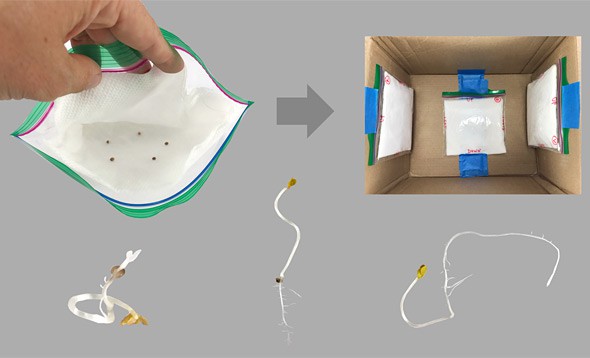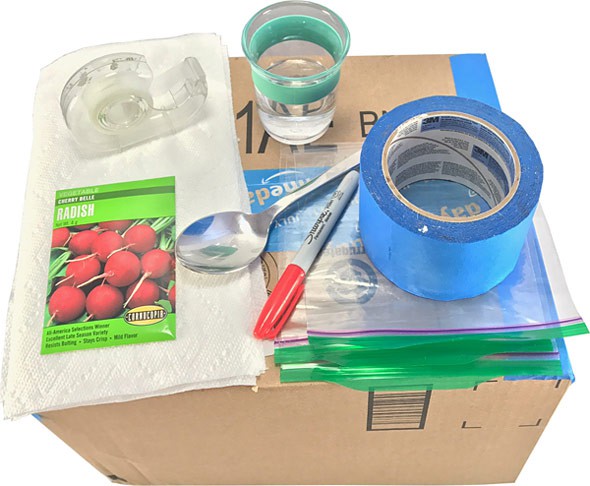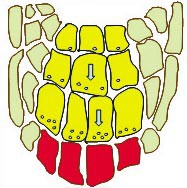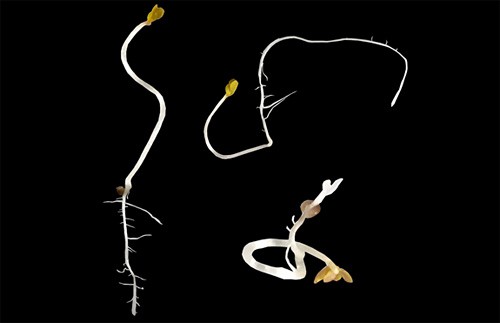Bending Plant Roots with Gravity
Summary
 Image Credit: Svenja Lohner, Science Buddies / Science Buddies
Image Credit: Svenja Lohner, Science Buddies / Science Buddies
Overview
How do plants know which way is up or down? How does this affect which direction their roots will grow? In this lesson plan, your students will investigate how changes in a plant's environment, like the direction of gravity, affect the shape of its growing roots over a period of several days.Learning Objectives
- Explain why environmental factors such as gravity affect root growth in plants
- Describe how plants respond to environmental inputs/stimuli based on experimental evidence
- Understand that environmental inputs can be sensed and transmitted by plants to trigger a behavioral response
NGSS Alignment
This lesson helps students prepare for these Next Generation Science Standards Performance Expectations:- MS-LS1-5. Construct a scientific explanation based on evidence for how environmental and genetic factors influence the growth of organisms.
|
Science & Engineering Practices
Constructing Explanations and Designing Solutions.
Construct a scientific explanation based on valid and reliable evidence obtained from sources (including the students' own experiments) and the assumption that theories and laws that describe the natural world operate today as they did in the past and will continue to do so in the future.
|
Disciplinary Core Ideas
LS1.B: Growth and Development of Organisms.
Genetic factors as well as local conditions affect the growth of the adult plant.
|
Crosscutting Concepts
Cause and Effect.
Cause and effect relationships may be used to predict phenomena in natural systems.
Phenomena may have more than one cause, and some cause and effect relationships in systems can only be described using probability. |
Materials
 Image Credit: Svenja Lohner, Science Buddies / Science Buddies
Image Credit: Svenja Lohner, Science Buddies / Science Buddies
Materials for teacher preparation and demonstration:
- A variety of plant seeds
- A growing plant
Materials per group of 2–4 students:
- Plastic zip-lock sandwich bags (3)
- Permanent pen (1) or a pen and tape
- Paper towels (3 full sheets or 6 half sheets)
- Water (0.25 cups)
- Radish seeds (15)
- Strong tape
- Large cardboard box (1)
Background Information for Teachers
This section contains a quick review for teachers of the science and concepts covered in this lesson.Geotropism (also called gravitropism) is the directional growth of an organism in response to gravity. Roots display positive geotropism when they grow downward (in the direction of gravity), while shoots display negative geotropism when they grow upward (opposite the direction of gravity). Among the first scientists to study geotropism was Charles Darwin, who, along with his son Francis, published The Power of Movement in Plants in 1880. Despite a long history of studying this subject, there are many questions about how geotropism actually works. Watch this time-lapse video to see a corn seedling root display geotropism.
The process can be broken down into three phases: perception, transduction, and response.
Perception is the sensing of environmental stimuli. Perception allows organisms to gain information about properties and elements of the environment that are critical to their survival. The perception of gravity by root tips is thought to be mediated by special cells called statocytes (see Figure 1). These cells contain small bodies that sink to the bottom of the cells in response to gravity. The term for this type of body is statolith. This perception process that takes place in the statocyte is essentially the same as dropping a rock to determine which way is down. The statocyte cell senses where the statolith touches inside the cell; now it "knows" which way is down.
 Image Credit
Image CreditThe cells in a plant root are protected by an outer layer called the root cap that is colored in red. The inner layer of cells are called statocytes (colored in yellow) and in each statocyte contains smaller structures called statoliths (colored in white) that move in the direction of gravity.
Figure 1. This diagram of a plant root illustrates the regions of gravity perception. Within the root cap at the apex (red), some cells develop into the gravity-sensing cells called statocytes (light green). These cells contain statoliths (small dots) that move in response to the direction of the gravity (toward the bottom). (Drawing by David Whyte, 2008).
The next step is for the statocyte to communicate this information to other parts of the root. The goal is to tell the part of the root that is growing which direction to go. To do this, it has to convert the signal generated by the falling statolith into a chemical signal. The term used for converting information from one form to another is transduction. The process of signal transduction is very important in biology. In the case of the statocyte, the signal from physical contact of the statolith is "transduced" into a chemical signal that is able to communicate with other cells.
The final step is the response of the growing cells to the signal indicating which way is down. Signal transduction from the statocytes to the root-tip cells results in a specific response: growth in the direction of the gravitational field. Molecular genetics, fine-laser ablation (this destroys very specific regions of the root to see how this affects growth), and zero-gravity environment experiments are some of the tools that are used to tease out the molecular mechanism by which plants sense and respond to gravity.
In this lesson plan, you and your students will be watching and recording three sets of seeds to see how the growing root tips respond to the change in the direction of gravity. The first set will be germinated while held vertically in a plastic bag. The second set will be germinated horizontally in a plastic bag, so the roots will be blocked from growing in the same direction as the gravitational field. The last set will be rotated 90 degrees to observe how quickly the roots respond to the change in direction of gravity.






